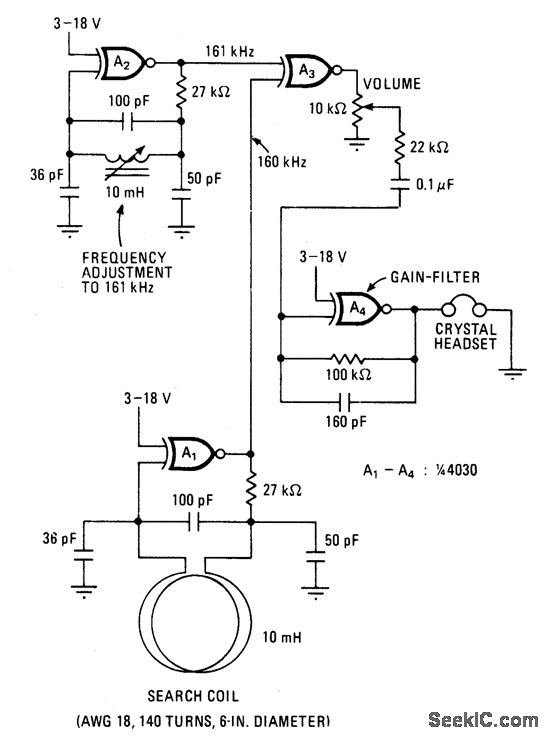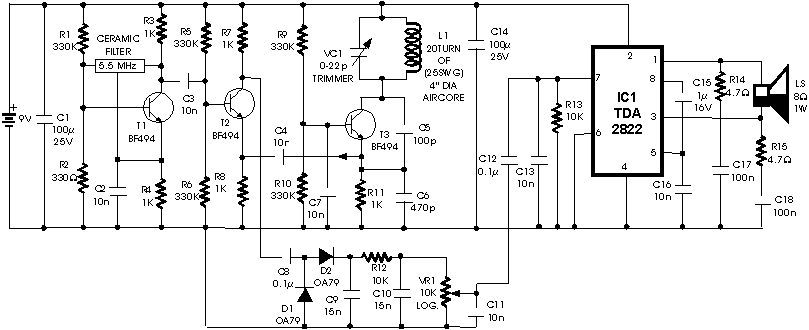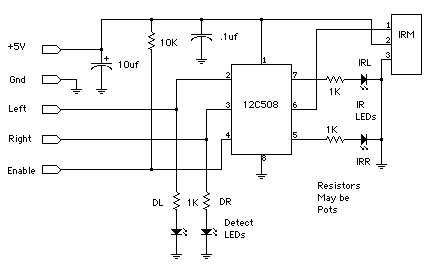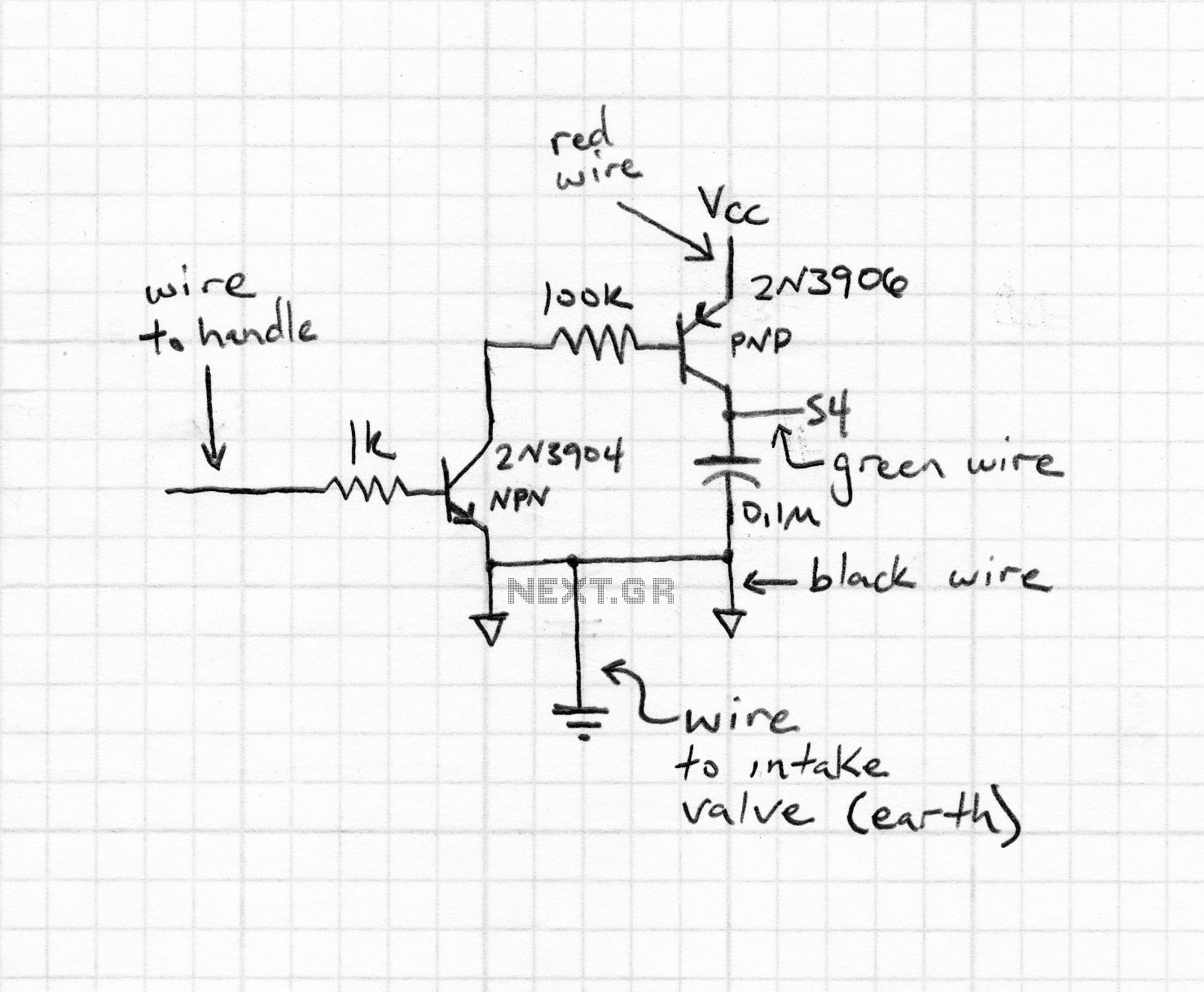
MICROPOWER METAL DETECTOR

This battery-powered metal detector utilizes four exclusive-OR gates found in the 4030 CMOS integrated circuit. The gates are configured as twin oscillators, with a search coil acting as the inductance element in one of the oscillators. When the coil approaches metal, the resulting change in its effective inductance alters the oscillator's frequency. Gates A1 and A2 form the two oscillators, which are tuned to 160 kHz and 161 kHz, respectively. The pulses generated by each oscillator are mixed in gate A3, producing an output that contains sum and difference frequencies at 1 kHz and 321 kHz. The 321 kHz signal is filtered out by a 10 kHz low-pass filter at A4, allowing the 1 kHz signal to be amplified for the crystal headset connected at the output. The device's sensitivity is adequate to detect coin-sized objects from a distance of one foot.
The described battery-powered metal detector is a sophisticated device that leverages the properties of CMOS technology to effectively identify metallic objects. The core of the operation is based on the oscillation principle, where the search coil's inductance plays a crucial role in frequency modulation. The two oscillators, configured by gates A1 and A2, operate at closely related frequencies, specifically 160 kHz and 161 kHz. This slight difference in frequency is essential for generating a beat frequency, which is the difference between the two oscillator outputs.
When the search coil is brought near a metallic object, its inductance changes, which in turn alters the frequency of one of the oscillators. The mixing of the outputs from the two oscillators in gate A3 results in a complex signal that contains both sum and difference frequencies. The output frequencies, specifically 1 kHz and 321 kHz, are critical for the detection process. The 321 kHz frequency, being higher, is filtered out using a low-pass filter at A4, which is designed to allow lower frequencies to pass while attenuating higher frequencies. This leaves the 1 kHz signal as the primary output for further processing.
The 1 kHz signal is then amplified to drive a crystal headset, providing auditory feedback to the user regarding the presence of metallic objects. The design ensures that the device is sensitive enough to detect small objects, such as coins, from a distance of approximately one foot. This capability makes the metal detector suitable for various applications, including treasure hunting and security screening. The use of CMOS technology not only enhances the efficiency of the circuit but also contributes to the portability and battery-powered operation of the device.This battery-powered metal detector uses four exclusive-OR gates contained in the 4030 CMOS integrated circuit. The gates are wired as a twin-oscillators and a search coil serves as the inductance element in one of the oscillators.
When the coil is brought near metal, the resultant change in its effective inductance changes the oscillator`s freque ncy. Gates A1 and A2 form the two oscillators which are tuned to 160 and 161 kilohertz respectively. The pulses produced by each oscillator are mixed in A3, its output contains sum and difference frequencies at 1 and 321 kHz. The 321 kHz signal is filtered out by the 10 kHz low-pass filter at A4, leaving the 1 kHz signal to be amplified for the crystal headset connected at the output.
The device`s sensitivity is sufficient to detect coinsized objects a foot away. 🔗 External reference
The described battery-powered metal detector is a sophisticated device that leverages the properties of CMOS technology to effectively identify metallic objects. The core of the operation is based on the oscillation principle, where the search coil's inductance plays a crucial role in frequency modulation. The two oscillators, configured by gates A1 and A2, operate at closely related frequencies, specifically 160 kHz and 161 kHz. This slight difference in frequency is essential for generating a beat frequency, which is the difference between the two oscillator outputs.
When the search coil is brought near a metallic object, its inductance changes, which in turn alters the frequency of one of the oscillators. The mixing of the outputs from the two oscillators in gate A3 results in a complex signal that contains both sum and difference frequencies. The output frequencies, specifically 1 kHz and 321 kHz, are critical for the detection process. The 321 kHz frequency, being higher, is filtered out using a low-pass filter at A4, which is designed to allow lower frequencies to pass while attenuating higher frequencies. This leaves the 1 kHz signal as the primary output for further processing.
The 1 kHz signal is then amplified to drive a crystal headset, providing auditory feedback to the user regarding the presence of metallic objects. The design ensures that the device is sensitive enough to detect small objects, such as coins, from a distance of approximately one foot. This capability makes the metal detector suitable for various applications, including treasure hunting and security screening. The use of CMOS technology not only enhances the efficiency of the circuit but also contributes to the portability and battery-powered operation of the device.This battery-powered metal detector uses four exclusive-OR gates contained in the 4030 CMOS integrated circuit. The gates are wired as a twin-oscillators and a search coil serves as the inductance element in one of the oscillators.
When the coil is brought near metal, the resultant change in its effective inductance changes the oscillator`s freque ncy. Gates A1 and A2 form the two oscillators which are tuned to 160 and 161 kilohertz respectively. The pulses produced by each oscillator are mixed in A3, its output contains sum and difference frequencies at 1 and 321 kHz. The 321 kHz signal is filtered out by the 10 kHz low-pass filter at A4, leaving the 1 kHz signal to be amplified for the crystal headset connected at the output.
The device`s sensitivity is sufficient to detect coinsized objects a foot away. 🔗 External reference





